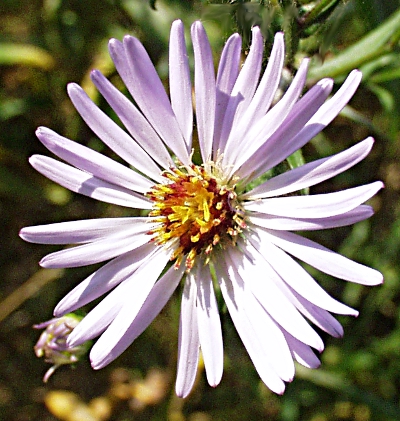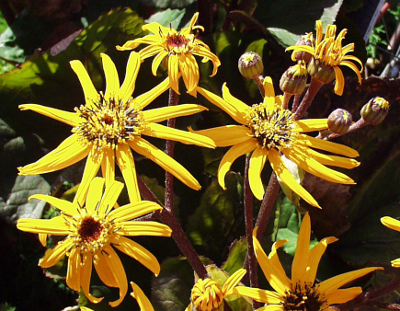Daisy family |

The family is named after the Aster

The
common blanketflower (Gaillaria aristata)
originates
from North America

Ligularia dentata – the home of the summer ragwort lies in East Asia
The worldwide represented, most species-rich family of dicotyledons in the world (more than 1000 genera with over 22,000 species) mainly consisting of herbs with a basal leaf rosette and usually alternate, toothed, lobed, feathery, corrugated, serrated or entire leaves. In the tropics, also shrubs, trees and vines can be found in the family. Common to all is that the individual flowers are combined into a big pseudanthium, which is surrounded by phyllaries.
The sepals are missing or are transformed into a pappus or similar structures which are attached later on the ripe fruit as a "parachute" for example. The bracts at the flower base in some species are transformed into paleae which cover the receptacle.
The florets consist of a inferior ovary, that is fused from 2 carpels. From it arise a corolla tube which merges into a usually slightly dilated throat, in which the stamens are inserted. The corolla tube often ends with 5 short lobes or in a long, wide ligule. Mostly 5 stamens are connate at the anthers into a tube. In hermaphrodite flowers, the hairy style pushes through the corolla tube, the throat and finally through the bonded anthers and presses out the pollen.
The fruits of Asteraceae are called "achenes", they are often dispersed by the wind or by animals (anemochory, zoochory).
The strategy of the Asteraceae
The advantage of the flower heads is that insects are attracted more effectively by a large pseudanthium, than of many tiny individual flowers. Another advantage is that the flower visitors can pollinate up to 100 flowers at the same time, without having to change the plant.
| General floral formula: |
| * or ↓ K0 [C(5) A5(connate)] G(2) inferior |
Hermaphrodite Asteraceae are protandrous, i.e., it first mature the male flower organs. In addition, the florets open from the outside inwards. Insects usually land on the periphery of the head. When the florets there are already in the female phase, they are pollinated by brought-along pollen. If the insect wanders now further inward, it reaches the flowers in the male stage, picks up the pollen and thus pollinate the next plant.
Evolution and Systematics
Evolutionary this characteristic flower heads are caused by a strong compression of the pedicels and the stem axis, so that the initial bracts became phyllaries and the inflorescence a pseudanthium. Some species in the periphery have ray florets and in the center disc florets, so that the appearance of a single large flower is even more convincing.
The daisy family are divided into two subfamilies: The lactiferous Cichorioideae have only ray florets with five short teeth. The Asterioidae possess either only disk florets or tridentate ligulate florets at the margin and mostly yellow disk florets in the center, that look like stamens and therefore imitate rich deposits of pollen for the insects.
Interesting notes
-
To the composites belong ornamental plants such as asters, marigolds, chrysanthemums, gerbera and dahlias, and medicinal herbs such as chamomile, coltsfoot and arnica.
-
Useful plants from this family are lettuce, artichokes, salsify, endive, artichoke, chicory and aromatic herbs such as wormwood and tarragon.
-
The sunflower, a well-known ornamental and useful plant, is a very impressive member of this family.
-
The wormwood, Artemisia absinthium, is used to make absinthe – a high proof alcoholic spirit.